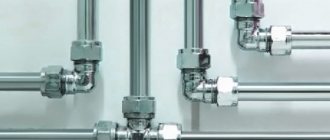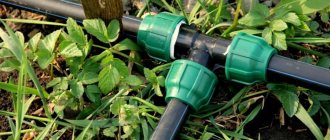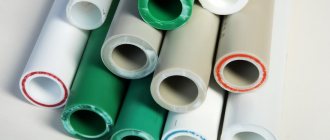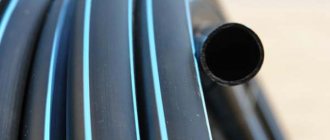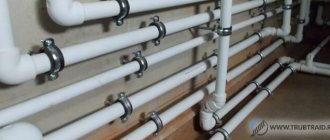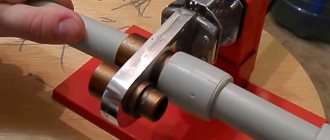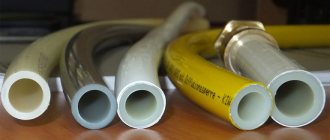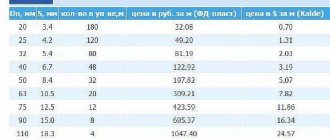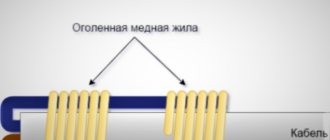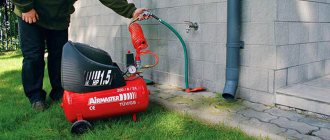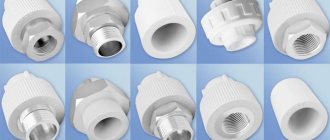Comfortable life in a country house or on a summer cottage implies the presence of water supply and sanitation. If there are no central communications in the SNT or cottage community, it is necessary to install the water supply system on your own or with the involvement of a contractor. The owner of a country property must clearly understand what materials need to be chosen. Metal pipes have been replaced by plastic pipes for water supply in the country. Their consumer qualities are well suited for laying external and internal routes and constructing watering routes for the vegetable garden.
Summer and winter type of pipeline
The first important issue is the difference between summer and winter water supply. Suitable for summer water supply and wastewater disposal:
- Stationary and collapsible. Stationary ones are represented by a non-removable design, which is installed for the entire long period of operation. In turn, collapsible ones can be dismantled with the onset of cold weather. When creating a collapsible structure, it should be taken into account that it must have good protection from mechanical stress.
- For winter water supply, a stationary water supply system is installed.
The type of pipes used also depends on the type of water supply. For prefabricated construction, polymer pipes with threads at the ends are suitable. A flexible hose is also often used, which can be quickly twisted if necessary.
Installation
The method of installing the pump depends on its type. A submersible pump (used for source depths greater than 8 m) is suspended on a chain or cable. If the unit is vibrating, you cannot use a metal cable - only a nylon cable.
Installation diagram of a hidden country water supply system
The surface self-priming pump should be installed on a level concrete base. It is necessary to build a canopy for it, or even better, a booth that will protect the unit from rain.
Plastic pipes
The main classification of pipes can be called the type of material used in manufacturing. Recently, plastic has been used quite often in the production of pipes for household pipelines. The advantages of plastic pipes include the following points:
- No deposits are formed. In the case of sewerage, high roughness of the inner surface causes blockages. Due to the peculiarities of the production method, the inner surface of plastic pipes has a low roughness index.
- The absence of corrosion on the surface, even after a long service life, means that there is no need for pipeline maintenance, as well as additional protection from high humidity.
- Despite the fact that in the production of this type of pipes products of the petroleum and chemical industries are used, during long-term operation no harmful elements are released into the environment.
- Bacteriological safety is at the highest level.
- If the service life of a metal structure is no more than one dozen years due to the fact that without special protection, temperature changes and high humidity cause corrosion and destruction of the structure of the material. As practice shows, plastic options are provided that they are buried taking into account soil freezing and provide protection from mechanical damage.
- The lightness of the pipes determines a significant simplification of transportation and installation.
Another undeniable advantage is the low cost.
How much will summer water supply cost at the dacha? Price of components
The cost of summer water supply can be calculated based on the following data:
- A HDPE pipe with a diameter of 40 mm and a wall thickness of 3.7 mm will cost 46 rubles. per linear meter (lm);
- the cost of a PN10 grade PP pipe with parameters 40x3.7 mm is 113 rubles/linear meter;
- a ball valve (polypropylene) with a flow area of 20 mm costs 122 rubles;
- the price of a polypropylene saddle for a pipe with a diameter of 63 mm (bend - ¾ inch) is 193 rubles;
- submersible pump Aquarius (model BTsPE 05-16U) costs 7,350 rubles.
The self-priming pump Aquarius (model BC 1.2-18) costs 3,900 rubles.
Hot and cold water
When designing a home's cold and hot water supply system, the following points should be taken into account:
- For drinking cold water, it is recommended to purchase polypropylene pipes.
- Polyethylene ones are suitable for hot water, as this material tolerates temperature increases better.
When creating a pipeline for hot water, you need to remember that significant heating of some types of plastic leads to increased plasticity.
Mine wells
Mine wells are constructed when the depth of the aquifer is small - up to 20 m. Centrifugal or vibration-type electric pumps are used to pump water out of mine wells. It also wouldn’t hurt to arrange a crane that can be used if the pump breaks down.
The well frame (cross section 1 X 1 m, 1.25 X 1.25 m, 1.5 X 1.5 m), depending on the depth, is made from logs with a diameter of 12-18 cm and buried 1.5-2 cm into the aquifer m. For the above-water part of the shaft well, pine is suitable, and for the lower part - oak, elm, alder, which do not affect the taste and smell of water. The crowns are pre-made with the obligatory adjustment of the logs and trimming to the plane of the inner side. They are fitted into a groove horizontally, connected vertically with inserted oak tenons, and in the corners - into an “oblique paw”.
Assembling the frame is the initial stage of well construction. After this, the mine and clay castle are marked. Then the soil is removed to a depth of 1-1.5 m, the assembled frame is placed in the shaft, a tripod with a pulley is installed and a waterproof clay castle is made, having a depth and width of about 1 m. The clay should be compacted.
Next, they dig a shaft, gradually removing soil from all sides to the thickness of the crown and bringing in logs for new crowns. They are pressed together with temporary staples.
To prevent the walls of the shaft well from warping and tearing, every 5 crowns, two parallel lower logs are made 20 cm longer on each side. The ends of such logs are placed in nests made in the walls of the shaft.
HDPE pipes
HDPE pipes are widely used:
- Water supply throughout the area.
- Supply of drinking water to the house.
- Water supply for various buildings, for example, baths and swimming pools.
A special feature of the material used is the ability to expand under high pressure. An example is the case of soil freezing: even if the water freezes in the system, the pipeline does not burst.
However, there is a significant drawback, which is susceptibility to ultraviolet radiation. Therefore, it is necessary to protect the pipes from exposure to the sun.
Well
If the aquifer is deeper than 8-10 m, it is necessary to drill a well. It’s unlikely that you can do it yourself; you’ll have to hire someone. The pleasure is not cheap - drillers charge a lot of money for their work.
But, having spent money on a well once, you will provide your dacha with clean water in the required volumes. If you want to save money, you can try to negotiate with your neighbors and make a well for several summer cottages.
In this case, the water supply system requires a borehole or submersible pump. These devices are significantly more expensive than their surface counterparts, but in terms of efficiency in providing clean water, they are unmatched
Features of water supply for a dacha from a well
To assess the effectiveness of the system, it is necessary to draw a project; it is advisable to display all the rises and bends of the pipeline, the length of horizontal sections, and the laying of pipes in the house. The diagram should also indicate the location of all water-consuming devices (faucets, taps, showers, water heaters, etc.).
The next parameter that must be taken into account when choosing a pump is the maximum pressure that the pump can produce.
To calculate the required pressure for the system, you need to know the highest point of the water.
— Required pressure. When determining the required pump pressure, keep in mind that 1 meter of vertical pressure is approximately equal to 10 meters of horizontal pressure (there are actually many factors that affect this ratio). If the characteristics of the pump indicate that the maximum pressure at zero power reaches hmax = 30 meters, then this means that vertically this pump will lift water to a height of 30 meters or at zero height it will be able to deliver water approximately 300 meters horizontally (but the water will flow weak stream). For example, you install a pump in the basement of a house or garage located 4 meters below ground level. The water entrance to the one-story house where water is supplied is located 30 meters away. This means that you need a pump with a head of more than 6 meters.
— Maximum volume of water consumption. It is calculated as the sum of water consumption for all possible water points simultaneously. For example, watering the area, a shower in the house, a sink in the kitchen, a toilet on the second floor, etc. For example, with the simultaneous use of a shower, two taps in the sink, and a toilet flush system, the total water consumption will be approximately 1.9 m3/h (0.7+0.4+0.4+0.4=1.9).
Selecting a pump for lifting water
For a water supply system, a country water supply system, a pump is required. Vortex or centrifugal devices are used. The vortex pump is used for supply from shallow depths and is suitable for wells. It is worth knowing that such equipment operates warmly, but does not produce noise during operation.
Centrifugal units are quite noisy, but can deliver water from great depths and are insensitive to low temperatures. Such a pump can supply water from a depth of no more than 10 meters.
Submersible pumps are used for deep wells. They are immersed in a well, from which water is supplied through pipes to the surface. The maximum depth from which water can be taken is 40-45 meters. For a plot of 10 acres and a small two-story house, a pump with the following parameters will be optimal:
— Electric motor power ranges from 250 W to 1400 W.
— Productivity — 1500-4000 l/h.
— Tank capacity is 70-100 liters.
— Lifting height from 8 to 50 m.
When making your selection, keep in mind that the data sheet indicates maximum specifications that must be met under certain conditions. With deviations from them, the parameters can be significantly lower.
Water supply by pumping station
If the water level in the well consistently exceeds 7 meters, a pumping station may be the best solution. It already has everything necessary to ensure complete water supply:
- centrifugal pump;
— input filter;
— check valve;
- receiver
— automatic overload and dry running protection system
- pressure switch
The capabilities of pumping stations are more extensive; such a system can completely supply an entire house of several floors with water. Of course, first you need to make all the calculations both for the installation itself and for the pipelines. The diameters of the pipes must comply with the installation recommendations, both at the inlet, before and after the pump. As a rule, for private water supply you should choose pipes DN 25 mm, 32 mm or 40 mm.
The pumping station for direct water extraction from the well must be located in close proximity to the well. To do this, you should allocate a place, it can be a caisson (sealed structure, container), in which the equipment will be well protected from the possibility of flooding with groundwater, and also sufficiently insulated from low temperatures in winter.
Advantages
— Remote location (outside the house) without noise.
— Automatic system
— Everything you need is there, eliminating the need to install additional equipment, which increases reliability.
Flaws
— It is necessary to equip a caisson - additional costs.
Scheme with storage capacity
Capacity (tank) plus a pump or pumping station.
This organization of water supply to a country house allows you to create the necessary supply of water.
Storage tank, installed outside the house or in the basement
To supply water to the water supply system, a pumping station is connected to the tank - a surface pump with a hydraulic accumulator and a pressure sensor. When the pressure in the accumulator drops, the pump turns on and brings it to the desired value set by the user.
Note: The hydraulic accumulator of the pumping station compensates for pressure peaks when the pump is turned on/off and significantly reduces the frequency of such turns on and off.
How to calculate the volume of a water tank? The instructions are quite obvious: it is equal to the product of the daily flow rate and the maximum interval between turning on the water supply.
Tip: In general, household water consumption is calculated based on a norm of 200 liters per day per person. Let’s say if two people permanently live in a country house and water is delivered on schedule twice a week, then the storage capacity should be at least 1600 liters.
Calculation: 200 (consumption per person per day) x 2 (number of inhabitants) x 4 (interval between days of water supply) = 1600 liters.
Stainless steel and copper
A serious problem with metal can be the appearance of corrosion on the surface during prolonged use without waterproofing. That is why they began to produce versions made of copper and stainless steel. They are reliable and durable, and can be used for supplying cold and warm water, as well as draining wastewater. They are often chosen by people who do not want to save money on water supply or drainage work.
Despite a fairly large number of advantages, the pipes in question are used extremely rarely today. This is due to the following points:
- There is a high probability of deposits and plaque appearing on the walls.
- When carrying out installation work, welding work is required.
- High cost, especially copper options.
- Heavy weight, which makes it difficult to carry out delivery and installation work.
- High requirements for insulation to eliminate the possibility of water crystallization when the soil freezes, which leads to a breakthrough of the system due to expansion of the liquid.
For a summer cottage, it is recommended to use such pipes only with careful insulation of the main line. The cost of insulation, the complexity of the work carried out, the cost of the materials used determine that a system of stainless and copper pipes is a very expensive investment.
Video description
This video shows the installation of pipes:
It consists of the following elements:
- The tank is designed to accumulate water, which will subsequently flow into the water supply system. It is positioned so that it is higher than the pipes through which water flows for irrigation, washing or other purposes.
- Water can simply flow out of the tank through the pipes under the influence of gravity. However, a pump can be additionally used to speed up its movement.
- A supply line must be installed for irrigation. Through it, water should flow from the tank to those pipes through which irrigation will be carried out.
- To water the garden, pipes with a large number of small holes lying on the ground can be used.
- For fruit trees, garden drip tape can be used.
- To connect to main pipes, special tees are used.
- When watering, it is convenient to fertilize the plants at the same time. To do this, provide a special container connected to pipes in which fertilizers are dissolved in water.
Summer water supply Source trubamaster.ru
Metal-plastic pipes
Metal-plastic pipes are also quite popular among summer residents. Their peculiarity lies in the following points:
- The structure is three-layer, each layer performs its own task.
- The inner and outer layers are made of polymer. This material can withstand high humidity and temperature changes; its low roughness does not lead to blockages.
- The layer between the plastic is made of aluminum. This metal has high ductility and is not susceptible to corrosion.
They have an aesthetic appearance and light weight. The plasticity of aluminum and the properties of plastic allow some versions of metal-plastic pipes to be bent, which reduces the number of connections due to the absence of the need for rotating elements. However, the multilayer structure and the use of aluminum significantly increase the cost of the product.
Drainage of the site
In soils with excess moisture, plants cannot gain a foothold and penetrate to nutrients, since the depth of roots is limited to a few centimeters of the surface layer. In this case, when developing a land plot, it is necessary to carry out drainage - draining the soil using trenches or pipes.
The installation of a drainage system is a labor-intensive and complex process, and it also requires considerable costs.
First, you need to use special instruments to determine the topography and groundwater level. If the soil on the site is clayey and the groundwater level is high, drainage is simply necessary. Effective drainage of the site is impossible without a deep (at least 1 m) street ditch. Water should be discharged towards the slope of the terrain. Such a ditch significantly reduces the groundwater level in the surrounding area. There are no particular problems with draining areas with a clearly defined slope towards or away from the street. In this case, to retain melt and storm water and direct it in the right direction, drainage ditches are dug.
If the site has a slope towards the street, it is necessary to dig a transverse ditch in front of the blind area of the house (to hold back the flow of water from the garden) and a longitudinal ditch (to discharge water into the street ditch).
If the site has a slope in the direction from the street, dig a transverse ditch along the fence, and a longitudinal one - to the garden. Therefore, the beds must be laid out across the direction of the slope.
Remember that drainage ditches protect the soil from waterlogging only during heavy rainfall and melting snow.
A drainage system on a flat site can be created as follows: In the lowest place of the site along the fence, a ditch should be dug 2 m long, at least 1 m deep and 50 cm wide. Low-lying areas on the site should be filled with the dug earth. The ditch is filled with construction debris, stones and household waste. When it is filled to the fertile layer, they dig another ditch with the same dimensions as the first. The dug soil is used to cover a ditch filled with waste, and also to fill the lowlands with it.
Soil drainage can also be done using a drainage well. It is constructed if there is no drainage system connected to the general drainage system.
Water flow diagram: a - slope of the terrain in the direction of the street:
1 - drainage ditch; 2 - fence; 3 - street ditch; 4 - drains; 5 - collector; 6 - slope of the terrain in the direction from the street: 1 - drainage ditch; 2 - vegetable garden beds; 3 - drain; 4 - pool-reservoir; 5 - collector
A drainage well is made as follows. First, they dig a hole at least 2 m deep. Its diameter is 1-2 m (depending on the size of the area to be drained). The resulting walls are covered with bricks, which do not need to be held together with mortar. In this case, water will seep through them. Then the drainage well is filled with broken bricks or rubble stones, and covered with a layer of peat and earth on top to prevent silting.
Drainage well. Pipe laying diagram
Pottery drainage. This is a system of long plastic or short clay pipe sections. They are laid end to end and backfilled in trenches that serve to collect and drain water. The pipes of the central branch of the system going to the drainage well are 10 cm in diameter, and the side ones are 7.5 cm. They connect to the central branch at an angle of 60°. To prevent the joints from becoming clogged, they are covered with ceramic tiles.
Trenches for pottery drainage should be 0.5-1 m deep and 0.3 m wide. When digging them, the top and subsoil layers of the earth are placed separately. A layer of coarse gravel (5 cm) is laid at the bottom of the trench, and pipes are placed on top of it, which are covered with gravel on top. A top layer of soil is placed on top of the gravel.
How to lay side drainage pipes depends on the type of soil. If the soil is clayey, the distance between the pipes should be shorter than on sandy soils (4.5 and 12 m, respectively).
Brick drainage. This drying method is usually used in small areas. A trench is dug along the length of the site, which is directed to the drainage well. It is filled halfway with rubble stone or broken brick, and a layer of gravel and topsoil are laid on top.
Drainage of hard artificial surfaces. Garden plots can become impassable as a result of heavy rain if there is no drainage. To ensure water flow, when concreting or asphalting any territorial area, it is necessary to provide a slight slope. It will ensure the outflow of water into a drainage ditch or drainage well. You can also install a hidden drain, for example in a patio or under a walkway. To do this, the halves of ceramic pipes are laid with a slight overlap of the ends in the center of the area, naturally giving a slope towards the east. To ensure water drainage, a 1.5 cm spruce is left in the center.
Drainage of a plot of land can also be carried out using combined techniques. For example, using the drainage network and raising the ground level on the site by adding imported soil. Regular application of rotted leaves, compost or peat helps to increase the moisture capacity of the soil without making it waterlogged. You can also plant moisture-loving plants and trees in an area with high soil moisture!
What you should know about PVC pipes
The term plastic pipes refers to many of their varieties. There are a large number of types of plastic, each with its own special performance qualities. PVC pipes are quite popular. They are the optimal solution at the time of creating a water supply or sewerage system. As previously noted, an increase in temperature can cause an increase in the flexibility index. This is why manufacturers indicate:
- For cold water, PVC is chosen.
- For hot water, only CPVC can be laid.
In addition, CPVC is also used for cold water.
Determination of nominal pressure
If metal pipelines can withstand a fairly high pressure, then with plastic ones everything is a little different. When purchasing plastic pipes, pay attention to the nominal pressure indicator, which is designated PN. It is recommended to purchase PN 10 and PN16 for cold water; PN20 and PN25 are suitable for hot water. For hot ones, versions with a higher nominal pressure are installed due to a decrease in strength due to heating of the material.
Types of water supply
Summer water supply from plastic pipes
The purpose of water supply in a country house can be divided according to seasonality of use and area of application. If the house is intended for year-round use, then the water supply line is used all year round. When the house is used only for summer holidays, it is subject to autumn conservation, during which it is necessary to drain the water from all consumers and drain the water supply. Those who live in arid climates or grow vegetables, fruits and ornamental plants in their garden will need to replace heavy rubber garden hoses with a neat and practical plastic pipe for summer water supply.
According to the operating requirements, it is possible to differentiate the water supply system into summer, winter, and street. The purpose of the line determines the choice of material.
What pipe diameter to choose
Another important indicator is the internal diameter. As a rule, for the main pipeline they are chosen with a diameter of 25-32 mm. This should be quite enough to reduce the pressure in the system. In the case when it is necessary to determine the exact indicator, a hydraulic calculation is carried out taking into account the operating characteristics of plumbing and other appliances and the power of the water supply source.
To summarize, we note the following points:
- The choice of material type is made taking into account which will be easiest to achieve hermetic joints. For example, steel pipes can only be connected efficiently by a welder of the 4th category.
- Polymer ones are suitable for summer cottages, as they have sufficient strength and do not collapse when water freezes.
- When choosing, the likelihood of corrosion on the surface is taken into account.
When purchasing pipes, you should pay attention to their integrity. Quite often there is a situation when, due to improper transportation or storage, cracks and other defects appear on the surface, curvature appears - all this can cause a decrease in the reliability of the pipeline being created.
Sources of water supply for a summer residence
The main sources of water for water supply in the country, which may be available on the site:
- central water supply
- river;
- pond or lake;
- well
- well
Let's consider the advantages and disadvantages of each water supply source.
Connection to the central water supply
If there is a centralized water supply near your site, you can connect to it. The advantages of this connection are constant pressure and water purification. However, in practice, water pressure and quality often do not meet standards.
Plus, you can't just tap into the pipeline—that's illegal. You will need to write an application to the water utility, provide a site plan with communications, draw up design documentation and obtain permission from the Sanitary and Epidemiological Station. The entire procedure takes several months and costs a lot of money.
Connection to the central water supply
The land must be connected to the central water supply by a specialist from a water supply company that has permission to carry out such work. Unauthorized use of water is prohibited
It is also impossible to use such water in an uncontrolled manner; for each cubic meter consumed you have to pay a fixed rate. Based on all this, not only many dacha owners, but also residents of private houses decide to drill a well or dig a well on their property.
Well
If you already have a well on your property, you can quickly organize a small supply of water for irrigation and basic household needs. If this is not the case, then you can arrange a well shaft.
The method is suitable for areas where the depth of the underground aquifer is at least 8-10 m.
The advantage of the option under consideration is the extreme simplicity of the system - it can be maintained and repaired on its own. Maintaining a well in normal working condition does not require any measurable costs.
The main disadvantage of water supply for a dacha from a well is the strictly limited water supply. Not every single well can provide enough water to meet all of a family's needs.
.
Pumping equipment for raising water from a well.
— Surface pump - a hose is lowered into a well to collect water with a filter at the inlet.
— The pumping station is an improved version of the surface pump, equipped with a control unit and a small storage tank located in a warm room. In both cases, water can be lifted from a depth of no more than 9 meters.
— Pumping station with a centrifugal pump and ejector — the ability to supply water from a depth of up to 45 m.
- Submersible pumps - can lift water from deep wells.
pump for a well in the country
Disadvantages of water supply from a well
- low efficiency,
- risk of clogging,
- a decrease in the level or complete shallowing of the source.
If there is no well at your dacha and you don’t need a lot of water, first compare the prices and labor costs for organizing a water supply based on a well and a well in the sand.
Perhaps a well will be a more effective solution.
Pump selection
. How to choose a pump for a well in a country house?
The main component of a water supply system from a well for a summer residence is a pump. They come in two types: submersible and surface.
Submersible pumps , as the name suggests, are immersed directly in water.
The submersible pump in the well must be located so that there is at least a meter of water below it to the bottom, and there must also be at least a meter of water above the pump before the water level (when it drops to a minimum).
This type of pump is quite sensitive to mechanical impurities in water: if there is a lot of sand in it, it will kill any, even the most powerful and expensive equipment. Therefore, it is necessary to install filters.
Surface pumps remain on the surface, and only the suction pipe is lowered into the water.
Surface pumps lift water from a shallow depth (no more than 9 meters) and do not have such high efficiency, but are easier to install and cheaper. For year-round water supply to a dacha, deep-well pumps or efficient pumping stations with built-in automation and holding tanks with ejectors are most often used (but the deeper the well, the more electricity the device consumes and the lower its efficiency).
The height of water rise at a pumping station with an external ejector is determined by the passport data of the corresponding model (from 15 to 40 m.) Pumps (pumping stations) with and without a built-in ejector lift water from 8 m.
An ejector (French éjecteur, from éjecter - to throw out from the Latin ejicio) is a device in which kinetic energy is transferred from one medium moving at a higher speed to another. The ejector, working according to Bernoulli's law, creates a reduced pressure of one medium in the tapering section, which causes suction into the flow of another medium, which is then carried away and removed from the place of suction by the energy of the first medium.
Wikipedia
And if you do not lower the external ejector into the well, but only screw it to the surface pump, then in terms of performance, such a design will not differ from a pump with a built-in ejector, and its suction height will be small.
For wells with unstable water levels, models with an alarm float are recommended. When the water level drops below the technical limit, pumping on these models automatically stops.
Features to pay attention to:
- Productivity (how many liters of water the pump supplies per minute). This depends on the power of the pump and the diameter of the pipe. You need to know how much water your family actually needs (sum up the approximate water consumption per minute of all users) and compare this to the maximum output of the appliance.
- Suction depth. Indicates the depth from which the device can pump water.
- Maximum pressure. determines the maximum height of the water column to which the pump can deliver water.
Pump characteristics
The most important feature of a pump is its performance. It should not be less than the flow rate of all simultaneously used points (faucets, drains) or the volume of water that is consumed within one hour.
However, do not buy a pump with too much power! The more often it switches to dry running, the faster it wears out.
When choosing a pump for a well, it is necessary to take into account the principle of its operation. According to the principle of operation, pumps are divided into vibration, centrifugal, and vortex.
Vibrating ones are the most economical and uncomplicated.
Good pressure, low efficiency and fragility are the main reasons why such pumps are chosen as temporary summer options.
Disadvantages:
- Quite noisy.
- There are problems in water with minor contaminants, since the particles interfere with the tight fit of the valves
Vibrating pumps are not intended for automatic water supply systems. Although the systems are nevertheless made on them and, surprisingly, still work.
Centrifugal are the most popular ; they meet most of the requirements for wells.
- make less noise
- don't vibrate
- lift water from great depths,
- have consistently high efficiency.
Vortex pumps differ from centrifugal pumps in the shape of the chamber and impeller, which gives them greater efficiency. They are somewhat simpler, somewhat cheaper and can easily withstand air penetration. However, they are incompatible with mechanical pollutants in water, even in very small quantities.
.
Choosing a tape for drip irrigation
When choosing a tape for drip irrigation in the garden, you need to take into account the features inherent in different types of tape devices.
Thus, a feature of “Labyrinth” type tapes is the presence of a built-in structural element on the surface of the material - a labyrinth. It slows down the movement of the water stream in the barrel and regulates its flow through the outlet holes. However, this manufacturing technology with an external labyrinth location has a significant drawback. There is a high probability of damage to the labyrinth when laying the tape.
In slot-type tapes, holes for water seepage are laser-cut every 20–100 cm on the walls. A labyrinth is built inside the tape along its entire length to eliminate turbulence in the moving water flow. When unwinding, the tape is installed “labyrinth side up” to ensure uniform flow of water through the water outlets. These tapes provide the easiest and most inexpensive method of watering. It should be taken into account that slotted tapes require good filtration up to 0.08 mm.
The emitter type of tapes is distinguished by the additional equipment of the holes with built-in flat droppers “facing inward”. This is a feature of this type: the droppers are not located outside, but are placed on the inner surface of the wall of the tape conduit. The vortex turbulent flow of water that occurs with this design inside the tape contributes to the self-cleaning of the droppers.
Tape water conduits with a wall thickness of up to 0.16–0.2 mm are used when it is necessary to make drip irrigation on the ground surface. For underground installation, tapes with a shell thickness of over 0.2 mm are used.
Concrete wells
In order to make a well from monolithic concrete, you must first dig a shaft. Then two formworks are installed in it: one along the walls of the shaft, the other at some distance from the first. Concrete is poured into the gap formed between the formworks. It must be left in the formwork until completely dry.
Cement is made using 400-grade Portland arch cement, sand, aggregate (gravel or crushed stone) and water. The ratio of parts should be as follows: 1: 2:3: 0.5.
First, cement must be mixed with sand in a mortar box, then you need to add water and use a shovel to mix everything thoroughly. The filler is moistened with water and added to the resulting solution.
Concrete is laid in layers of 15 cm and compacted until laitance appears. In order for the concrete to harden well, it is necessary to lay it for 7 days with damp sawdust or burlap, which must be moistened with water several times during the day.
DIY capillary system
For installation you will need the following elements:
- special tape for watering (emitter);
- tape plugs;
- plastic container for water;
- fittings (for connecting pipes);
- fitting with 3/4 external thread (for cutting into a plastic container);
- faucet for fitting and fitting with transition from external to internal thread;
- hose coupling;
- filter;
- polypropylene pipes;
- fittings (for connecting tape and pipes).
Step-by-step instructions for performing the work
Choose a place to place a container of water. It must be taken into account that the system operates if there is pressure, that is, the higher the container, the higher the pressure and pressure.
An emitter strip with a barrel at a height of 10 meters consumes 3-4 liters per hour.
The pressure is 1 bar.
For irrigation, 0.1 bar is enough, that is, the barrel is at a height of 1 meter, but in dry weather this is not enough, so you need to make height calculations based on the conditions.
After choosing a location, a fitting is cut into the container at least 10 cm from the bottom. This measure is aimed at preventing the entry of dirt and debris - all the dirt will remain at the bottom of the container.
A tap is connected to the fitting.
An adapter to the pipe is installed on the tap.
The pipe is laid out in its place near the beds or seedlings, perpendicular to them.
A tap is installed at the end of the pipe.
This will allow you to flush the system from dirt and regulate the pressure by opening and closing the tap.
- Holes for fittings are made in the pipe opposite each of the beds.
- A tape for watering is attached to the fittings.
- The tape is carried to the desired location, and a plug is placed at the end.
- Installation is complete.
This type of installation is intended for a mechanical irrigation system, which is controlled manually using a tap or pump, instead of a container of water (how to find water for a well).
For an automatic system, it is necessary to install consoles, which cannot be done independently without the help of professionals.
This is an expensive but useful service that can save water and moisten the soil in the right quantities.
